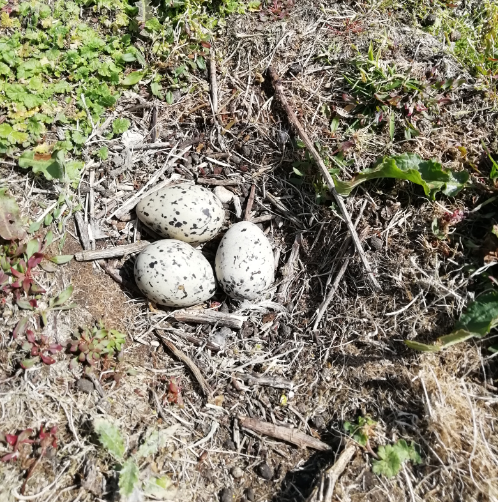|
Special thanks to Tara Adcock from BirdWatch Ireland for this update on the Dalkey Islands Tern Project With the arrival of the Terns to the Dalkey Islands, it’s been all hands - on deck getting the breeding sites ready for the upcoming nesting season. So far, we have counted 15 Terns (both Common and Arctic) on Maiden Rock and 5 Arctic Terns on Lamb Island. No eggs have been laid yet, although there’s plenty of courtship activity taking place with males arriving regularly with sandeels and sprat to their eager mates. While Roseate Terns have not yet made their presence known, we’re hoping that nest boxes on Maiden Rock and Lamb Island might entice a few pairs to lay down roots on the islands. Roseate Terns have bred on Maiden Rock as recently as 2016, so we’ll be keeping our eyes peeled over the coming season! Oystercatchers, like the Terns, have also been busy, with two nests, (containing 3 eggs each), found on Lamb Island, and a courting pair spotted on Maiden Rock. On Tuesday, the 14th of May, Steve Newton, the Dalkey Island Tern Conservation Project Manager, and I, set out for the islands. Our first stop was Dalkey Island, where we unloaded our gear before nipping across to Lamb Island as the tide fell, (some of us more nimbly than others, with Steve thoroughly putting me to shame!). Our task for the day – creating a grid of alternating canes each approximately one metre apart on Lamb Island to try to deter Gulls from landing in the Tern colony and predating chicks and eggs. The idea behind this simple method is that at one metre distances, the canes are placed too close together for Lesser Black – backed Gulls (wingspan 135-150cm), Herring Gulls (wingspan 130-150cm) and Great Black – backed Gulls (wingspan 150-170cm) to land between, while still allowing space for the smaller Arctic, Common and Roseate Terns to fly into the colony. This was tried in 2016 on the Inner Farne and Brownsman Islands off the northeast coast of the UK with good success (Boothby et al., 2019). Fingers crossed it will help the Lamb Island subcolony over the upcoming season! With a good proportion of the canes in place, it was time to head back to the mainland for the first Tuesday evening Tern Watch Event of the season. Johnny the boatman and his able navigator, Bowzer, were on hand to safely ferry us back across the Dalkey Sound. We were incredibly lucky with the weather for our first nature watching event and hopefully it’s a good omen for the upcoming season! In total, we spotted 17 bird and two mammalian species. The Terns were joined by diving Gannets further out to sea, and Razorbills and Manx Shearwaters on their way to and from their breeding grounds (telescopes, provided by BirdWatch Ireland, were a definite necessity for this spectacle!). Closer to shore, a Black Guillemot pair, which are nesting in the wall of the harbour, bobbed on the sea before taking flight, their white wing patches startling against the jet black of their bodies. Cormorants basked, wings outstretched to dry, on the rocks between Maiden Rock and Lamb Island among roosting Gulls and Terns. Grey seals, ever curious, peeked above the water at passing boats, while rabbits were a common sight bounding across Lamb Island. Finally, although not of the avian or mammalian persuasion, we were treated to the spectacle of this beautiful ship passing through the Dalkey Sound toward the end of the evening. All in all, it was a really pleasant night and it was great to see some familiar faces from last years season popping down again to check out the Terns! Public goodwill and understanding are integral to the success of the project. The Dalkey Islands, being on the edge of an urban hub, are ideally located for showcasing the beauty and ecology of birds along with mammals such as seals and harbour porpoises, as well as introducing people to the importance of projects such as the EU Life Roseate Tern Recovery Project. To this end, Tern Watch Events will continue to be held every Tuesday evening from 5 – 8pm at Coliemore Harbour, Dalkey until the 30th of July. In addition, beginning June 2nd, morning Tern Watch Events will be held every second Sunday at Colimore Harbour from 11am – 1pm, followed by three one hour Guided Walks on Dalkey Island from 2:30 – 5:30pm. A massive thank you to everyone who came down to the first Tern Watch Event of the season, and I look forward to many more inspiring morning and evenings over the coming months! References: Boothby, C., Redfern, C., & Schroeder, J. (2019). An evaluation of canes as a management technique to reduce predation by gulls of ground nesting seabirds. International Journal of Avian Science, 161, 453-458.
0 Comments
|
More Blogs to Read
AuthorThis blog is maintained by various people from the project team. Archives
August 2020
Categories
All
|
Roseate Tern LIFE Project is supported by the LIFE Programme of the European Union
LIFE14 NAT/UK/000394 ROSEATE TERN
LIFE14 NAT/UK/000394 ROSEATE TERN













 RSS Feed
RSS Feed